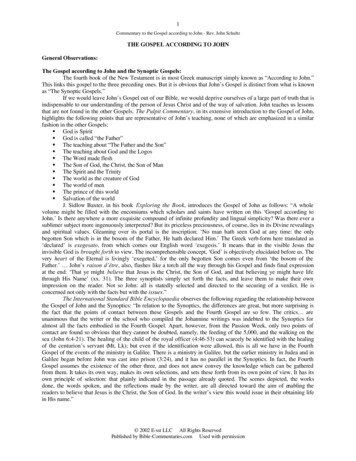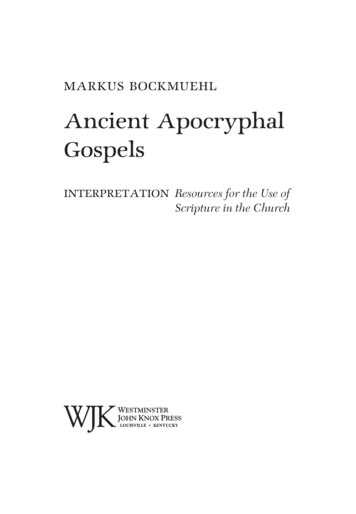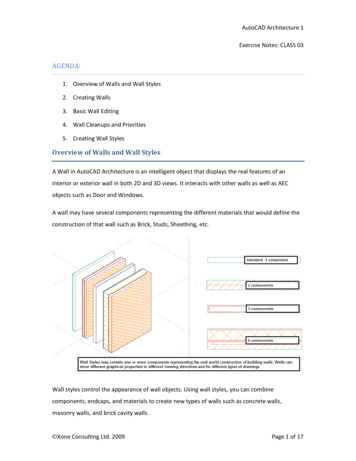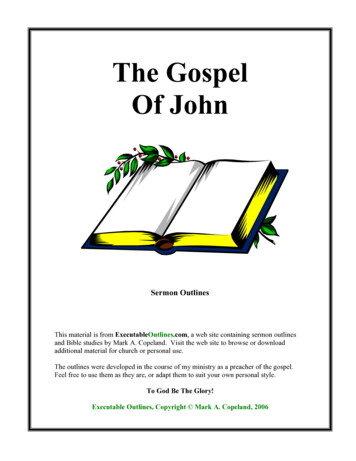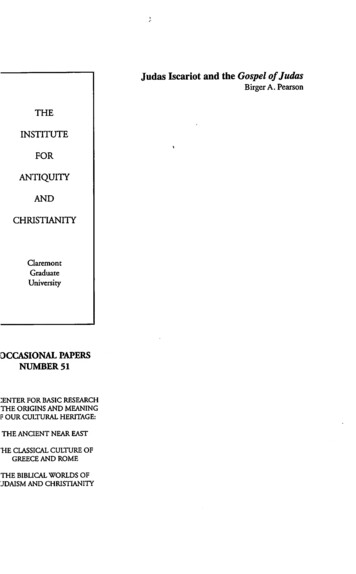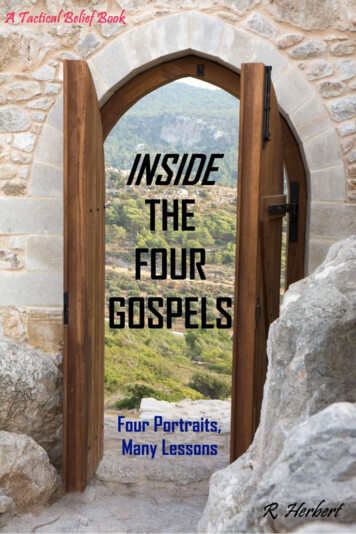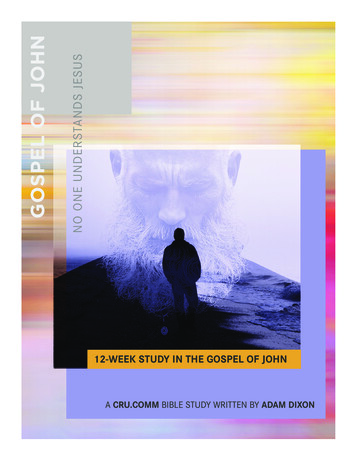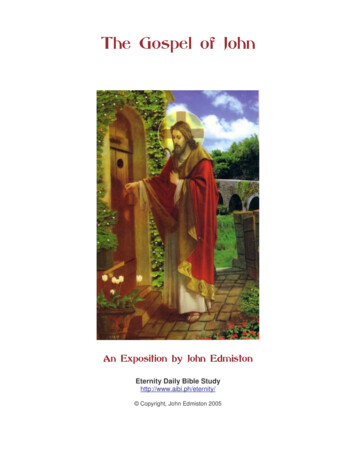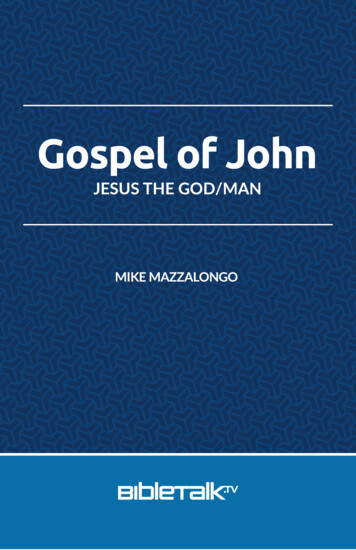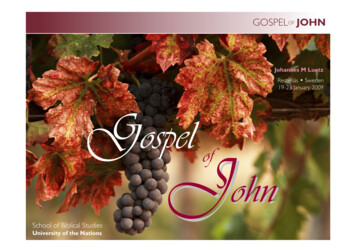
Transcription
Photo: Stephen WallsJohannes M LuetzRestenäs Sweden19-23 January 2009GospelSchool of Biblical StudiesUniversity of the NationsJohnof
ATTITUDE“The longer I live, the more I realize the impact of attitude on life.Attitude, to me, is more important than facts. It is more importantthan the past, than education, than money, than circumstances,than failures, than successes, than what other people think or sayor do. It is more important than appearance, giftedness or skill. Itwill make or break a company. a church. a home. Theremarkable thing is we have a choice everyday regarding theattitude we will embrace for that day. We cannot change ourpast. we cannot change the fact that people will act in a certainway. We cannot change the inconveniences. The only thing we cando is play on the one string we have, and that is our attitude. I amconvinced that life is 10% what happens to me and 90% of how Ireact to it. And so it is with you. We are in charge of our Attitude.—Charles Swindoll, born 1934American Writer and Clergyman”
TABLE OF CONTENTS“ Did I not tell you that if you BELIEVED, you would see the glory of God? ”—John 11:401. The Gospel2. The Signs3. The Glory
CONTEXT OF JOHNContextPhoto: NASA“Context”: derived from Latin “contextus”(con- “together” texere “to weave”)“The circumstances that form the setting for an event, statement oridea, and in terms of which it can be fully understood andassessed.” (Oxford Dictionary, page 367)
THE GOSPELThe Gospel (“Good News”):1.2.3.4.Book: Literary form invented by Mark (1:1)Timeless truth: God’s plan of salvation (Isaiah 61:1)Jesus: God’s messenger of His plan of salvation (Luke 4:18)Jesus: God’s message of Salvation (Luke 9:6)
THE GOSPELS“ The joyous good news of salvation in Jesus Christ. ”—Nelsons New Illustrated Bible Dictionary, page“ The record of Jesus’ life and teaching in the first four books ofthe New Testament The four Gospels ascribed to St.Matthew, St. Mark, St. Luke, and St. John all give an account ofthe ministry, crucifixion, and resurrection of Jesus Christ, althoughthe Gospel of John differs greatly from the other three. ”—Oxford Dictionary, page 728
FOUR GOSPELSWhy four Gospels of the One Gospel?Four distinctive portraits of Jesus (not exact photographic likeness).Compare 4 Gospels (main idea, reason written):Matthew: Jesus is the Messiah-King(this gospel emphasises Jesus as fulfillment of OT prophecy)Mark: Jesus is the Suffering Servant(this gospel emphasises the human side of Jesus)Luke: Jesus is the Saviour / Seeker of the lost (this gospelemphasises that Gentiles as part of God’s redemptive plan)John: Jesus is the (this gospel emphasises )
MIRACLES OF JESUSPower over SicknessMatthewMarkLukeMan with leprosy8:2-41:40-425:12-13Centurion‘s servant8:5-13Peter‘s mother-in-law8:14-151:30-314:38-39Two men from Gadara8:28-345:1-158:27-359:2-72:3-125:18-25Woman with bleeding9:20-225:25-298:43-48Two blind men9:27-31Man mute possessed9:32-33Man with shriveled hand12:10-133:1-56:6-10Blind, mute possessed12:22Canaanite w‘s daughter15:21-287:24-30Boy with demon17:14-189:17-299:38-43Blind Bartimaeus, etc.20:29-3410:46-5218:35-43Paralysed man7:1-1011:14John
MIRACLES OF JESUSDeaf mute7:31-37Possessed in synagogue1:23-26Blind man at Bethsaida8:22-264:33-35Crippled woman13:11-13Man with dropsy14:1-4Ten men with leprosy17:11-19The high priest’s servant22:50-51Official’s son Capernaum4:46-54Sick man, pool Bethesda5:1-9Man born blind9:1-7Power over NatureMatthewMarkLukeCalming the storm8:23-274:37-418:22-25Walking on water14:256:48-515,000 people fed14:15-216:35-44John6:19-219:12-176:5-13
MIRACLES OF JESUS4,000 people fed15:32-38Coin in mouth of fish17:24-27Fig tree withered21:18-228:1-911:12(-)25Catch of fish5:4-11Water turned to wine2:1-11Another catch of fish21:1-11Power over DeathMatthewMarkLukeJairus’s daughter9:18(-)255:22(-)428:41(-)56Widow’s son at NainLazarusJohn7:11-1511:1-44
FOUR UNIQUE PERSPECTIVESE.g. criminals crucified with Jesus:1. Matthew 27: two “robbers” crucified with him – one on hisright, one on his left – no conversation reported2. Mark 15: two “robbers” crucified with him – one on his right,one on his left – both are reported as heaping insults on Jesus3. Luke 23: two “criminals” crucified with him – one on his right,one on his left – one criminal insulted him, other pleaded formercy. In verse 43 Jesus says: “I tell you the truth, today you willbe with me in paradise.”4. John 19: two “others” crucified with him – Jesus in the middle– Jesus focuses on his family and gives Mary into John’s care
FOUR UNIQUE PERSPECTIVESE.g. Peter whacking off ear:1. Matthew 26:51: “With that, one of Jesus’ companions reached forhis sword, drew it out and struck the servant of the high priest,cutting off his ear.” (no healing reported)2. Mark 14:47: “Then one of those standing near drew his sword andstruck the servant of the high priest, cutting off his ear.” (no healingreported)3. Luke 22:50-51: “And one of them struck the servant of the highpriest, cutting off his ear. But Jesus answered, ‘No more of this!’ Andhe touched the man’s ear and healed him.” (healing)4. John 18:10: “Then Simon Peter, who had a sword, drew it out andstruck the high priest’s servant, cutting off his right ear. (The servant’sname was Malchus.)” (no healing, but name of Peter and high priest’sservant given.)
SYNOPTIC GOSPELSMatthew, Mark, Luke have much in common: Similar arrangement, order Similar geographical focus, progression (GalileeJerusalem) Similar content material (Mt. 3:13-17, Mk. 1:9-11 and Lk. 3:21-22) Similar language (Mt. 10:22a, Mark 13:13a and Luke 21:17):“All men will hate you because of me.” (verbatim agreement)Conclusion: The first three Gospels agree extensively in language,material and order, though strict chronological order was notfollowed by any. Because of these similarities the first three Gospelsare called “Synoptic Gospels” – from the Greek word “synopsis,”(seeing together). [“syn” together with; “optic” seeing.]
COMPARISONSMathematical Comparisons:(Source: NIV Study Bible, page 1437) 91% of Mark’s Gospel is contained in Matthew 53% of Mark’s Gospel is found in LukeOverlap“Synoptic Problem”who borrowed from whom?Problems: Agreement: Who copied / “plagiarised” from whom? Disagreement: Who got it wrong?Solution: Study with integrity“Spirit of Truth” to guide (John 14-16)
SYNOPTICS AND JOHNSYNOPTIC GOSPELS Jesus teaches inword pictures Jesus teaches in parables(nearly 60 parables) Jesus teaches mainly aboutthe Kingdom of God Jesus is a “man of action”(many miracles) Jesus often demandssilence after miracles Jesus’ humanity emphasised Jesus’ life: linear, chronologicalGOSPEL OF JOHN Jesus’ language isless picturesque Jesus teaches in discourses(no single parable) Jesus teaches mainly aboutHimself Jesus is more “measured”(far fewer miracles) Jesus’ miracles are signs toreveal who He is Jesus’ divinity emphasised Jesus’ life: cyclical, theological
PARABLES OF JESUSPARABLEMatthewMarkLukeLamp under bowl5:14-154:21-228:16; 11-33Wise foolish builders7:24-276:47-49New cloth, old coat9:162:215:36New wine, old wineskins9:172:225:37-3813:3-8; 18-234:3-8; 14-208:5-8; 11-154:30-3213:18-19Sower and soilsWeedsMustard seed13:24(-)4313:31-32Yeast13:33Hidden treasure13:44Valuable pearl13:45-46Net13:47-50Owner of house13:20-2113:52Lost sheep18:12-14Unmerciful servant18:23-3415:4-7John
PARABLES OF JESUSPARABLEMatthewWorkers in vineyard20:1-16Two sons21:28-32Tenants21:33-44Wedding banquet22:2-14Fig tree24:32-35Faithful and wise servant24:45-51Ten virgins25:1-13Talents (minas)25:14-30Sheep and 112:42-4819:12-27Growing seed4:26-29Watchful servants13:35-3712:35-40Moneylender7:41-43Good Samaritan10:30-37Friend in need11:5-8John
PARABLES OF JESUSPARABLERich foolMatthewMarkLuke12:16-21Unfruitful fig tree13:6-9Lowest seat at the feast14:7-14Great banquet14:16-24Cost of discipleship14:28-33Lost coin15:8-10Lost (prodigal) son15:11-32Shrewd manager16:1-8Rich man and Lazarus16:19-31Master and his servant17:7-10Persistent widow18:2-8Pharisee and tax collectorJohn18:10-14Interesting Fact: There is no single parable in the entire Gospel of John.
SUMMARYSYNOPTIC GOSPELS The Synoptics presentbasically one perspectiveon the life of Jesus The Synoptics are morehistorically holistic andchronologicalGOSPEL OF JOHN The Gospel of Johnpresents a distinctlydifferent perspective The Gospel of John ismore historically selectiveand theologicalÎ Linear historyÎ Spiritual synthesisof the life of Jesusof the life of JesusSummary: The Gospel of John expresses “spiritual ideas” in “spiritual language.” It wasmost probably composed after years of profound meditation on the meaning of Christ.
CONCLUSION“The [four Gospels] were the first books of the NewTestament to be accepted as authoritative by the earlychurch. Today the four Gospels remain our only reliablesource of information about the central figure of thehuman race. We may never fully understand how theGospels originated and what sources each writer used forhis account. But a more important challenge than solvingthe literary mysteries of the Gospels is learning toappreciate the unique portrait that each writer offers ofJesus and growing in our love and devotion to Him.”—Nelsons New Illustrated Bible Dictionary, p. 520
JOHN’S UNIQUENESSESData, stories, events, and people peculiar to John: Prologue / Epilogue Referring to Jesus as “Logos” Nicodemus mentioned 3 times (nowhere else in NT) 5 of the 7 miracles are unique to John Disciples called in Jordan valley (Synoptics: Galilee) Temple cleansing in beginning (Synoptics: end) Only Gospel to mention length temple construction(46 years 2:19-20)
GOSPEL OF JOHN (1 of 2)NO 4YES 5 NO linear chronologyNO parablesNO birth/nativityNO Galilean ministry focusNO baptism (passive)NO human genealogyNO Sermon on the MountNO wilderness temptationYES cyclical theologyYES discoursesYES prologue/epilogueYES Judean ministry focusYES baptism (active)YES divine preexistenceYES Holy Spirit teachingYES sudden appearance
GOSPEL OF JOHN (2 of 2)NO 4YES 5 NO eschatology / end timesNO human childrenNO lepers/publicansNO prophecy about templeNO transfigurationNO last supperNO ascensionNO exorcismsYES focus on “right time”YES children of GodYES invalid (record 38 yrs.)YES prophecy by high priestYES prayer for disciplesYES footwashingYES Peter reinstatedYES Satan enters Judas
LINGUISTIC TRAITSLanguage: Modest vocabulary Simple diction, profound thought Characteristic Johannine vocabulary Words charged with symbolism Emotive atmosphere (13:30 “And it was night.”) Interprets Hebrew into Aramaic“which in Aramaic is.” (5:2; 19:13; 19:17)
CONTRASTSExamples of contrasts found in the Gospel of knessLightFleshSpiritJudgmentEternal LifeBelowAbovePhysical BirthSpiritual BirthEarthly WaterLiving WaterEarthly BreadBread of LifedevilGodChildren of the devilChildren of God
AUTHORSHIP (1 of 7)Author familiar with geography of Palestine: Knows about temple (2:20 and 10:23) Knows there were two distinct Bethanys (1:28, 11:1, 12:1) Knows Cana in Galilee (2:1, 2:11, 4:46, 21:2) Knows Sychar near Shechem (4:5) Knows Jerusalem:a) Sheep Gate and surroundings (5:2)b) Pool of Siloam (9:7)c) Olive grove – Kidron Valley (18:1)d) Judge’s seat – Stone Pavement (19:13)e) Knows place of the Skull (Golgotha) (19:17)
AUTHORSHIP (2 of 7)Author familiar with Jewish customs / feasts: Knows Jews and Samaritans did not relate (4:9) Knows duty of circumcision takes precedence overworking on Sabbath (7:22) Knows details regarding JewishFeast of Passover (12:1; 18:28; 19:14) Knows details regarding Jewish Feast of Tabernacles (7:2) Knows details regarding Jewish Feast ofDedication (Hannukah) (10:22)
AUTHORSHIP (3 of 7)Author familiar with Old Testament: Knows and quotes OT Scriptures (e.g. 2:17)“Zeal for your house will consume me.” (Psalm 69:9) Includes OT allusions or themes (e.g. shepherd)“I am the good shepherd; I know my sheep and my sheepknow me – just as the Father knows me and I know theFather – and I lay down my life for the sheep. I haveother sheep that are not of this sheep pen. I must bringthem also. They too will listen to my voice, and thereshall be one flock and one shepherd.” (10:14-16) –Æ compare Israel’s blessing: “May the God before whommy fathers Abraham and Isaac walked, the God who hasbeen my shepherd all my life to this day, .” (Gen. 48:15)
AUTHORSHIP (4 of 7)Author left clues about named / unnamed disciples:Introduction introduces person who is never named (1:35-51)1.) and 2.) two disciples, of which one is Andrew (1:40)3.) Andrew’s brother Simon (Peter-Cephas) (1:42)4.) Philip (1:43)5.) Nathanael Bartholomew (1:45-51)Subsequent passages introduce:6.) Judas Iscariot (6:71)7.) Thomas (11:16)Disciples not mentioned in John:8.) Matthew – already has a Gospel under his belt9.) James, son of Zebedee -- died early [42-44AD], unlikely candidate (Acts 12:1-2)10.) and 11.) James son of Alpheaus, and Thaddeus -- not mentioned in church history12.) This leaves John son of Zebedee! 5
AUTHORSHIP (5 of 7)John’s prominent position implicates him as author:The Apostle John was prominent in the early church but isnot mentioned by name in this Gospel. He is mentionedfrequently throughout all other Gospels. The omission of hisname would be natural if he wrote the Gospel, but hard toexplain otherwise.
AUTHORSHIP (6 of 7)John may have been helped by an editor / writer:Look at John 21:20-24: “20Peter turned and saw that the disciple whom Jesusloved was following them. (This was the one who had leaned back against Jesus atthe supper and had said, “Lord, who is going to betray you?”) 21When Peter sawhim, he asked, “Lord, what about him?” 22Jesus answered, “If I want him toremain alive until I return, what is that to you? You must follow me.” 23Becauseof this, the rumor spread among the brothers that this disciple would not die. ButJesus did not say that he would not die; he only said, “If I want him to remain aliveuntil I return, what is that to you?” 24This is the disciple who testifies to thesethings and who wrote them down. We know that his testimony is true.” “we”: this is the first time this occurs. Æ Who is “we”? Chapter 21 different Æ Gospel could end at 20:30-31 Another John? John the elder/presbyter? Editorial board?Conclusion: John author even if helped by later editor
AUTHORSHIP (7 of 7)Conclusion: Powerful Eyewitness!The Apostle John stresses that he is a credible eyewitness ofJesus (1:14, 16). It can be assumed that he made frequentreference to the exact “time of day” and mentions peculiardetails to show that he himself was present when the eventstook place. The whole Gospel appears “experienced,” e.g.: John the Apostle was a disciple of John the Baptistbefore he became one of Jesus’ disciples (1:35-40)Implication Æ With preparer of “the Way” John present from beginning when Jesus called disciples(“It was about the tenth hour.” 1:39)Implication Æ With Jesus from the very beginning
AUTHORSHIP (7 of 7)Conclusion: Powerful Eyewitness! (cont’d.) John present with Jesus and Samaritan woman at the well(“It was about the sixth hour.” 4:6-7)Implication Æ Can personally vouch for conversation details John present at Jesus’ first miracle – mentions detail(number and carrying capacity of stone water jars. 2:1-11)Implication Æ John was personally present as Jesusperformed his first miracle and launched his public ministry John present at Jesus’ last miracle – records how Jesus wasmoved with emotion: “Jesus wept.” (11:35)Implication Æ John personally saw the tenderness of theheart of God, plus witnessed Jesus conclude his public ministry
AUTHORSHIP (7 of 7)Conclusion: Powerful Eyewitness! (contd.) John present when Jesus predicts his betrayal (13:21-30)Implication Æ John was Jesus’ friend and confidant, entrustedwith information “no one else at the meal understood.” (13:28) John present at Jesus’ arrest [John is the only Gospel writer toname the “high priest’s servant,” i.e., “Malchus” (18:10)]Implication Æ John knew religious establishment (18:13)and was in position to know high priest’s prophecy (11:49) John was known to the high priest and thus was ableto bring in Peter to witness the trial (18:15)Implication Æ John was right there with Jesus when Peterdenied his Master
AUTHORSHIP (7 of 7)Conclusion: Powerful Eyewitness! (contd.) John present at the foot of the cross as Jesus entrusts Maryinto his care: “Here is your mother.” (19:25-27)Implication Æ John was right there at the crucifixion site asan eyewitness and trusted “relative” of Jesus John present at the cross until after Jesus had died –“.one of the soldiers pierced Jesus’ side with a spear,bringing a sudden flow of blood and water. The man whosaw it his testimony is true.” (19:34-35)Implication Æ John attests as eyewitness: Jesus 100% dead! John beat Peter running to the tomb (20:1-8)Implication Æ John was first eyewitness at empty tombWith Peter he is the first “believer” in the resurrection
AUTHORSHIP (7 of 7)Conclusion: Powerful Eyewitness! (contd.) John is the first disciple to recognise the risen Lord:Look at John 21:4-11: “4Early in the morning, Jesus stood on the shore, but thedisciples did not realize that it was Jesus. 5He called out to them, “Friends, haven’tyou any fish?” – “No,” they answered. 6He said, “Throw your net on the right sideof the boat and you will find some.” When they did, they were unable to haul thenet in because of the large number of fish. 7Then the disciple whom Jesus loved saidto Peter, “It is the Lord!” As soon as Simon Peter heard him say, “It is the Lord,” hewrapped his outer garment around him (for he had taken it off) and jumped intothe water. 8The other disciples followed in the boat, towing the net full of fish, forthey were not far from shore, about a hundred yards. 9When they landed, they sawa fire of burning coals there with fish on it, and some bread. 10Jesus said to them,“Bring some of the fish you have just caught.” 11Simon Peter climbed aboard anddragged the net ashore. It was full of large fish, 153, but even with so many the netwas not torn.”Implication Æ John spiritually “sharp” resurrection eyewitness
AUTHORSHIP (7 of 7)Conclusion: Powerful Eyewitness!John was personally present at all of Jesus’ major life events.This makes him an authoritative eyewitness Gospel writer(21:24). Æ John is both “the other disciple” as well as thedisciple “Jesus loved.” (20:2 connects the two terms)
WHAT WE HAVE TOUCHEDINTIMATEEYEWITNESS“ That which was from the beginning, which we have heard, which wehave seen with our eyes, which we have looked at and our handshave touched — this we proclaim concerning the Word of life.—1 John 1:1”
JOHN THE APOSTLEWhat was the Apostle John like as a person? Galilean fisherman (Matt. 4:18-22, Mark 1:16-20)(possibly from Capernaum, Mark 1:21) From wealthy family; his father and brother had boatand “hired servants.” (Mark 1:19-20) Son of Zebedee, brother of James (John probably 2ndborn. Synoptic Gospels always mention brother first) Man of decision – he immediately followed Jesus(see refs. above; tried to stop exorcist: Luke 9:49-50) Bit of a hothead – “Sons of Thunder” (Mark 3:17) –(offered to call fire on Samaritan village. cf.: Luke 9:51-56)
JOHN THE APOSTLEWhat was the Apostle John like as a person? Ambitious – asked to be seated next to Jesus in theMessianic Kingdom (Mark 10:35; Matt. 20:20-23) One of Jesus’ most intimate companions:These three (Peter, James and John) alone witnessed:a) Healing daughter of Jairus (Mark 5:37, Luke 8:51)b) transfiguration (Matt. 17:1-2, Mk. 9:2, Lk. 9:28-29)c) Jesus’ agony in Gethsemane (Mt. 26:37, Mk. 14:33)d) John and Peter: Passover supper prep. (Luke 22:8)
JOHN THE APOSTLEWhat was the Apostle John like as a person? Prominent leadership position among disciples (Acts 1:13) Present when Peter healed the crippled beggarin front of the temple (Acts 3) Present with Peter in the investigation of the conversion ofthe Samaritans (Acts 8:14-25) – Must have had heart-change:(earlier: “fire from heaven” to destroy Samaritans (Luke 9:51-56)(later: “Holy Spirit fire” to bless Samaritans (Acts 8:17) “Pillar” of the church (Gal. 2:9)Æ John started out with “rough” edges changed by Jesus’ love:(In epistles message reduced to: “little children, love one another”)
EXTERNAL EVIDENCEFrom where written? AD170: Muratorian Fragment: “John wrote the fourthGospel on request of the Asian bishops and was aided bythe revision of all.” AD177: Iranaeus (pupil of Polycarp the student of John):a) John lived in Ephesus until a very old age.b) “John published his gospel in Ephesus” (not “wrote”)c) “John, the disciple of the Lord, who also had leaned uponHis breast, did himself publish a Gospel during hisresidence at Ephesus in Asia.”
EXTERNAL EVIDENCEFrom where written? (contd.) Dominant tradition: John banished to Island of Patmos(during Domitian’s reign 81-96 AD). After he beheld the“Revelation” in Patmos, John returned to Ephesus where hewrote the 5 writings that bear his name (Gospel of John, 1, 2,and 3 John, Revelation) and where he is thought to have diedsome time after Trajan became emperor (in 98 AD) Other traditions: Tertullian (about 160-220 AD) saysJohn ended up in Rome where he was “plunged, unhurt, intoboiling oil.”
DATING JOHNJohn‘s tomb in Ephesus. (Photo: Johannes Luetz)Taking the external evidence and Biblical context together:Conclusion:Gospel of John probably written from Ephesus
DATING JOHNWhen was the Gospel written? John left out destruction of the temple (70AD)even though he knew the info Æ John 16:1-2 John implies Peter had already died the “kind ofdeath” Jesus had prophesied earlier (Jn. 21:19), pointingus to a “post-Peter’s-death-date” (64-68AD)First conclusion:Book written sometime after 70AD.
DATING JOHNWhen was the Gospel written? Second century papyri of the Gospel of Johnfound in Egypt and dated 135AD (allowing enough timefor it to reach circulation narrows date to 100AD) No emphasis on “persecution” as a theme centralto Christian Gospel may mean the book was writtenbefore Emperor Domitian re-engaged persecution (90AD)Second conclusion:Book written sometime before 90-100AD.
DATING JOHNPhoto: Roman Triumphal arch panel copy from Beth Hatefutsoth, showing spoils of Jerusalem temple.Taking both conclusions together narrows the dating:Conclusion:Gospel of John probably written between 70-90AD.
ORIGINAL READERSTo whom did John write? Unlike Luke (1:1-4) John mentions no addressee Unlike the Gospels of Matthew and Mark, John’s originalreaders are not quite as apparent at first glance John interprets Hebrew and gives meanings in Aramaic John uses both Jewish and Greek thought forms in hispresentation of Christ Readers probably not in Palestine (John gives detailedgeographical information to inform “uninformed” readerse.g. Æ 2 Bethanys, one 2 miles from Jerusalem (11:18)
ORIGINAL READERSTo whom did John write? (contd.) The many Jewish festivals suggest Jewish readership The explanations about the many Jewish festivals suggestsnon-Jewish readership (“to avoid ceremonial uncleanness,” 18:28)John writes a new Gospel for a new non-Jerusalemcentric church era (temple destroyed, most Apostles /eyewitnesses dead, etc.) His Gospel is inclusive and extends itsreach from Jewish believers to Greek Gentiles beyond AsiaMinor.
ORIGINAL READERSScriptures:Universality: “true light that gives light to every man.” (1:9)“Lamb of God, who takes away the sin of the world.” (1:29)“not condemn but save the world through him.” (3:17)“when I am lifted up draw all men to myself.” (12:32)Gentiles: “look at the fields! They are ripe for harvest.” (4:35)“Many Samaritans believed this man Savior of world.” (4:39-41)“I have other sheep. I must bring them also.” (10:16)“.and not only for that nation but also for the scattered children ofGod, to bring them together and make them one.” (11:52)
PRECIOUS TRUTHJohn portrays Jesus for the widest possible readership.This is the one reason why the fourth Gospel hasspoken so deeply to Christians in all ages.
TABLE OF CONTENTS“ Did I not tell you that if you BELIEVED, you would see the glory of God? ”—John 11:401. The Gospel2. The Signs3. The Glory
HORIZONTAL CHART
STRUCTURE OF JOHNPrologue(1:1-18)Book ofSigns(1:19 –chapt. 12)Jesus’personBook ’PUBLICPRIVATEMINISTRY MINISTRYEpilogue(chapter21)
STRUCTURE OF JOHNPROLOGUE Revelationof Jesus(1:1-4)GOSPELRevelationof Jesus(1:19 chapter 6)Rejectionof Jesus(1:6-11)Receptionof Jesus(1:12-18)Rejectionof Jesus(chapters7-12)Receptionof Jesus(chapters13-21)
KEY THEME“Just believe”“Jesus did many other miraculous signs in the presence of hisdisciples, which are not recorded in this book. But these arewritten that you may believe that Jesus is the Christ, the Son ofGod, and that by believing you may have life in his name.”
DEFINITIONS“BELIEVE”“ To place one’s trust in God’s truth. ”—Nelsons New Illustrated Bible Dictionary, page 170“ accept the statement of someone as true have faith in the truth or existence of. ”—Oxford Dictionary, page 149“TRUTH”“ that which is true or in accordance with fact or reality. ”—Oxford Dictionary, page 1807
BELIEVE: ACTIONJohn’s concept of believing: Action!John stresses his concept of believing: The verb “to believe”(pisteuein) is found nearly a hundred times in the gospel,though the noun “belief” [faith] (pistis) does not occur. ForJohn, saving faith is a verb, carrying the sense of activetrust in Jesus. It is not a static noun.
PROLOGUEDeliberate Parallel“In the beginning, God ” (Genesis 1:1)God speaks Æ Creation happens“In the beginning was the Logos” (John 1:1)Jesus speaks Æ Salvation happens
CHAPTER 17 Names of God in John chapter 1:Name 1: Word (1:1)Name 2: Lamb of God (1:36)Name 3: Rabbi (1:38)Name 4: Messiah (1:41)Name 5: Son of God (1:49)Name 6: King of Israel (1:49)Name 7: Son of Man (1:51)Æ Prior to the 1st sign Jesus is introduced by 7 titles.
CREATION IN 7 ACTSGENESIS:Day 1: LightDay 2: Sky, SeaDay 3: Land, VegetationDay 4: Sun, Moon, StarsDay 5: Living CreaturesDay 6: ManDay 7: God rests, Blesses SabbathÆIn “Seven Acts” God speaks Creation into being.
SALVATION IN 7 ACTSJOHN:Sign 1: Water turned to wineSign 2: Healing official’s sonSign 3: Healing lame manSign 4: Feeding of 5,000Sign 5: Walking on waterSign 6: Blind man healedSign 7: Lazarus raised to lifeÆIn “Seven Signs” Jesus speaks Salvation into being.
NUMBER “SEVEN”The Bible is full of the number “seven”:E.g.: Seven days of Creation (Genesis 1)E.g.: Seven years of plenty / famine (Genesis 41)E.g.: Seven days of Passover Feast (Exodus 13:3-10)E.g.: Seven year cycle year of Jubilee (Leviticus 25)E.g.: Seven nations Israelites to displace (Deut. 7:1)E.g.: Seven days of encircling Jericho (Joshua 6)E.g.: Jesus: forgive seventy x seven times (Matthew 18:21)ÆIn the Bible the number “seven” occurs 100s of times.
NUMBER “SEVEN”John’s two big books:Book ofRevelationGospel ofJohnAct 1Act 2Act 3Act 4Act 5Act 6Act enBowlsSeven“I Saw”Seven“NoMore”Sign 1Sign 2Sign 3Sign 4Sign 5Sign 6Sign 7Waterturned towineHealingofficial’ssonHealinglame manFeeding of5,000Walkingon waterBlind manhealedLazarusraised tolife
BIBLE AND “SEVEN”Number “Seven”In the Bible the number “Seven” evokes the sense ofcompleteness. (E.g. Phrase, “Lord God Almighty” occurs 7times in Book of Revelation: 1:8, 4:8, 11:17, 15:3, 16:7, 19:6, 21:22)
7 SIGNS, 7 DISCOURSES7 SIGNS:7 DISCOURSES:Sign 1: Water turned to wineDisc. 1: Must be born againSign 2: Healing official’s sonDisc. 2: Living WaterSign 3: Healing lame manDisc. 3: Unity Father and SonSign 4: Feeding of 5,000Disc. 4: True Bread of LifeSign 5: Walking on waterDisc. 5: True LightSign 6: Blind man healedDisc. 6: True ShepherdSign 7: Lazarus raised to lifeDisc. 7: Hour comeÆ “Seven Signs” are linked to “Seven Discourses.”
7 SIGNS7 SIGNS:7 DIVINE DEMONSTRATIONS:Sign 1: Water to wineDivine PurificationSign 2: Official’s sonDivine WordSign 3: Lame manDivine HealingSign 4: 5,000 fedDivine NourishmentSign 5: Walk on waterDivine PowerSign 6: Blind manDivine LightSign 7: Lazarus raisedDivine Life(in abundant supply)(with immediate effect)(on God’s own initiative)(for eternal satisfaction)(over nature’s forces)(for the whole world)(for all who believe)Æ Seven “Divine Demonstrations” reveal Jesus’ Glory.
TABLE OF CONTENTS“ Did I not tell you that if you BELIEVED, you would see the glory of God? ”—John 11:401. The Gospel2. The Signs3. The Glory
WHAT’S IN A NAME?“Now while he was inJerusalem at the PassoverFeast, many people sawthe miraculous signs hewas doing and believed inhis name.” (John 2:23)In ancient times an individual’s “name”summed up his whole person.
I AM JESUS YHWHExodus 3:14: I AM WHO I AM: The name by which God wished to be known and worshiped inIsrael – the name that expressed his character as the dependable and faithful God who desiresthe full trust of his people (see Ex. 3:12 Æ “I will be” is completed by “with you.”) Jesus appliedthe phrase to himself; in so doing Jesus claimed to be God and risked being stoned to deathfor blasphemy. (John 8:58-59)Exodus 3:15: THE LORD: The Hebrew for this name is “Yahweh.” It means “He is” or “He willbe” and is the third-person form of the verb translated “I will be” (verse 12) and “I AM” (verse14). When God speaks of himself he says, “I AM,” and when we speak of him we say, “He is.”(NIV Study Bible Note Ex. 3:14-15)
I AM JESUS YHWHPh
Matthew, St. Mark, St. Luke, and St. John all give an account of the ministry, crucifixion, and resurrection of Jesus Christ, although the Gospel of John differs greatly from the other three. —Oxford Dictionary, page 728 “ The joyous good news of salvation in Jesus C
